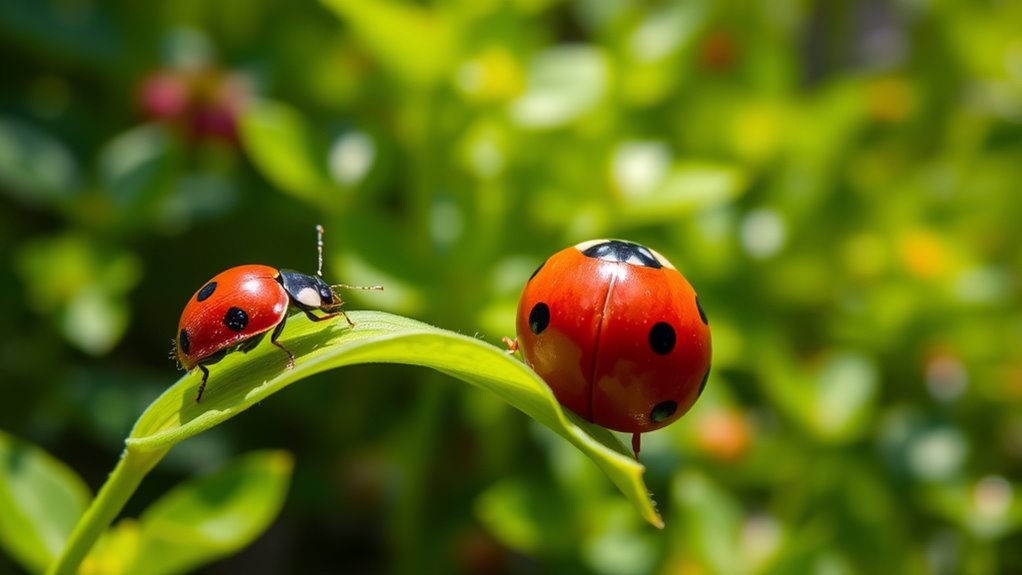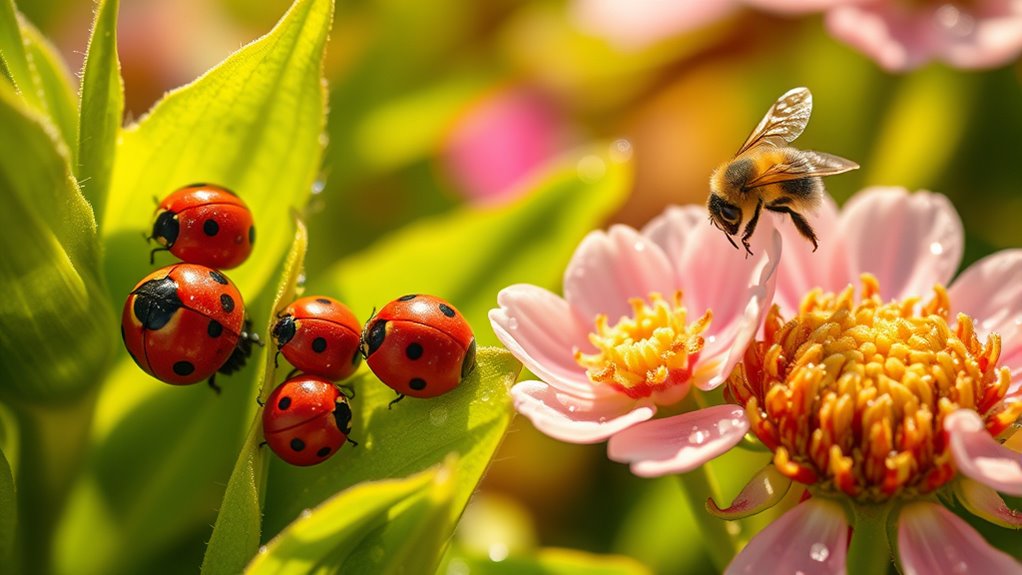When I think about the best beneficial insects for pest control, I immediately think of live ladybugs and beneficial nematodes. They help tackle everything from aphids to soil-dwelling pests without chemicals. Green lacewing eggs are another fantastic option, plus the handy sachets of Amblyseius swirskii for mites. It's essential to choose the right pest allies based on your garden's size and conditions. If you're curious about more options and strategies, there's plenty more to explore!
Key Takeaways
- Live ladybugs effectively control aphids and mealybugs, providing quick results within 24 hours when released at dusk.
- Beneficial nematodes target over 200 soil-dwelling pests, promoting a non-toxic approach for both indoor and outdoor gardening.
- Green lacewing eggs serve as natural predators of common pests, with adults hatching in about three weeks for ongoing pest management.
- Understanding specific pest types and aligning beneficial insect choices with garden conditions is crucial for effective pest control.
- Regular treatments and strategic application timing enhance long-term pest management success while maintaining a healthy garden ecosystem.
Natures Good Guys Live Ladybugs (1500 Count)
If you're looking for an effective, eco-friendly solution to pest problems in your garden, Natures Good Guys Live Ladybugs (1500 Count) is your answer. These vibrant reddish-orange beetles aren't just cute; they're powerful pest controllers. Each ladybug can tackle slow-moving pests like aphids and mealybugs, making them essential for organic gardening. I love that they arrive with a guarantee of live delivery and an educational sheet packed with tips. Just remember to release them at dusk, and they'll thrive in your garden. With 1,500 ladybugs covering about 1,000 square feet, they've truly become my garden's best allies.
Best For: Gardeners seeking an eco-friendly and effective solution for pest control in their organic gardens.
Pros:
- Guaranteed live delivery ensures that customers receive healthy ladybugs for immediate use.
- Educational materials included help users understand how to effectively release and care for the ladybugs.
- Natural pest control can reduce reliance on chemical pesticides, promoting a healthier garden ecosystem.
Cons:
- Limited storage life requires careful planning to use the ladybugs within 1-2 weeks of arrival.
- Effectiveness may vary based on initial pest populations and environmental conditions.
- Requires proper release timing to ensure survival and effectiveness, which might be inconvenient for some users.
Live Beneficial Nematodes – Kills Soil Dwelling and Wood Boring Insects (5 Million)
For gardeners seeking an effective, natural solution to pest problems, Live Beneficial Nematodes are an exceptional choice. With 5 million nematodes, they target over 200 soil-dwelling and wood-boring insects. I appreciate their non-chemical approach, making them ideal for both indoor and outdoor gardening. To use them, simply mix the nematodes with water and apply them to moist soil. I've noticed significant reductions in pest populations, especially gnats and click beetle larvae. Just remember to keep the soil moist post-application. With the right conditions, these tiny allies can be a game-changer for your garden's health!
Best For: Gardeners looking for a natural, effective solution to control soil-dwelling and wood-boring insect pests.
Pros:
- Non-chemical approach ensures safe usage in indoor and outdoor gardening.
- Targets over 200 pest species, providing a broad range of effectiveness.
- Positive customer feedback highlights significant reductions in pest populations.
Cons:
- Effectiveness may vary based on environmental conditions and timing.
- Mixed results reported for certain pests, such as grubs, leading to uncertainty in outcomes.
- Requires moist soil and warm temperatures, which may not always be achievable.
Live Beneficial Nematodes – 15 Million Hb+Sc+Sf
Live Beneficial Nematodes – 15 Million Hb+Sc+Sf are an excellent choice for gardeners and homeowners looking to combat pests without harming beneficial insects. These nematodes effectively target over 200 types of soil-dwelling and wood-boring pests, making them versatile for both indoor and outdoor use. I've found them easy to apply; just mix with water and spray after moistening the soil. Storing them in the fridge keeps them fresh for up to 30 days. While user experiences vary, many reported healthier plants after treatment. I recommend applying them early in spring for the best results against pests like fleas and termites.
Best For: Gardeners and homeowners seeking an eco-friendly solution to control soil-dwelling and wood-boring insect pests without harming beneficial insects.
Pros:
- Kills over 200 species of pests, making it highly versatile for various applications.
- Safe for use around humans and pets, promoting a non-toxic pest control method.
- Easy to apply and store, ensuring convenience for users.
Cons:
- Mixed reviews on effectiveness, with some users reporting limited success against specific pests like fleas.
- Shipping conditions can affect product viability; reports of nematodes arriving warm have raised concerns.
- Effectiveness may vary based on environmental factors, requiring monitoring and potential reapplications.
Scanmask Steinernema Feltiae Beneficial Nematodes for Pest Control
Scanmask Steinernema Feltiae Beneficial Nematodes are an excellent choice for anyone seeking an effective, natural solution to pest control in their gardens or indoor plants. These nematodes target over 230 pests, including armyworms and fire ants, by entering their bodies and releasing bacteria that kill them. I love that they're safe for my family, pets, and beneficial insects. Applying them is simple—just mix with water and use a sprayer in the evening. I've noticed significant reductions in pest populations after just one treatment, and I recommend follow-ups for complete eradication. Give these nematodes a try; you won't regret it!
Best For: Gardeners and homeowners looking for a natural, effective solution to control a wide range of insect pests without harming beneficial organisms.
Pros:
- Safe for people, pets, and beneficial insects, ensuring an eco-friendly pest control option.
- Effective against over 230 pests, providing broad-spectrum protection.
- Simple application process that can be done with common gardening tools.
Cons:
- Requires refrigeration upon arrival and has a limited shelf life after opening.
- Nematodes only target larval stages, necessitating multiple treatments for complete pest control.
- Effectiveness may vary based on pest life cycles and environmental conditions.
Natures Good Guys – Green Lacewing Eggs on Hanging Card (2,500 Eggs)
If you're looking for an effective way to manage pest problems in your garden, the Green Lacewing Eggs on hanging cards are a fantastic choice. With 2,500 live eggs, these little guys are natural predators of aphids, spider mites, and more. I've seen firsthand how they improve plant health, especially when conditions are right—around 70°F and 60% humidity. Users report adult lacewings hatching in three weeks, which is encouraging! Just keep in mind that for larger infestations, you might need extra cards. Overall, they're a worthwhile addition to any pest management strategy in your garden.
Best For: Gardeners looking for a natural and effective solution to manage pest issues, particularly against aphids and spider mites.
Pros:
- Effective natural predator for various soft-bodied insects, improving overall plant health.
- Guaranteed live delivery with quick shipping and well-packaged products.
- Can be used alongside other beneficial insects for enhanced pest control.
Cons:
- Low hatch rates reported by some users, with effectiveness varying based on environmental conditions.
- Some dissatisfaction with the glue used on cards, potentially hindering lacewing release.
- Mixed reviews on customer service and product reliability, particularly during winter months.
Nema Globe Nematodes Organic Insect Control Pot Popper
For anyone struggling with pesky fungus gnats in their indoor plants or hydroponic systems, the Nema Globe Nematodes Organic Insect Control Pot Popper is an excellent solution. Each Pot Popper contains eight infusion bio-pouches, totaling eight million nematodes, perfect for targeted treatment. I noticed a reduction in gnats after 1.5 weeks, with my terrarium becoming 95% gnat-free within two weeks. While they won't eliminate all pests, their effectiveness is impressive if applied correctly. Just remember to keep them moist and avoid overwatering your plants. This method's convenience makes it a solid choice for smaller infestations.
Best For: Those dealing with fungus gnats in indoor plants, greenhouses, or hydroponic systems looking for an organic control method.
Pros:
- Effective reduction of gnat populations, achieving up to 95% gnat-free results within two weeks.
- Convenient application with individual bio-pouches tailored for specific plant needs.
- Non-refrigerated and has a 6-month shelf life, making storage easy.
Cons:
- May not eliminate all gnats entirely, as some can return after initial effectiveness.
- Requires patience for results, with noticeable effects taking 5-10 days.
- Limited coverage for larger infestations compared to nematodes mixed into soil.
1500 Live Ladybugs – Guaranteed Live Delivery
Looking for an effective and natural way to manage pests in your garden? I found that ordering 1500 live ladybugs (Hippodamia convergens) is a game-changer. With guaranteed live delivery, they quickly tackle aphids, moth eggs, and other pests. I appreciate the educational sheet that comes with them, offering release tips and fun facts. While some reviews mention shipping delays and a few casualties, most customers, including myself, noticed significant pest control within 24 hours. Just remember to cool them in the fridge before release, and you'll see the benefits of these little allies in no time!
Best For: Gardeners seeking a natural and effective solution for pest management.
Pros:
- Quick pest control: Many users report significant reduction in pest populations within 24 hours.
- Educational value: Comes with an informative sheet that provides tips and fun facts about ladybugs.
- Eco-friendly: Utilizes a natural predator to manage pests, making it a safer alternative to chemical pesticides.
Cons:
- Shipping issues: Some customers experienced delays and concerns about the number of ladybugs received.
- Casualties during transit: A few ladybugs may arrive dead due to shipping conditions.
- Acclimation required: Ladybugs need to be cooled and released at the right time for optimal results, which may require additional effort from users.
1500 Pre-Fed Live Ladybugs for Aphid Control
Pre-fed live ladybugs are an excellent choice for anyone aiming to tackle aphid infestations organically, especially gardeners who want to engage children in sustainable practices. I love how these little helpers, specifically the 1500 BuddyBugs, are guaranteed to arrive healthy and ready to feast on pests like aphids. Many customers rave about their effectiveness in improving plant health and aesthetics. However, I've heard mixed reports about mortality rates and ladybugs not always eating pests right away. Following dispersal instructions and providing water sources can enhance their success. Overall, they're a fantastic, chemical-free option for pest control in any garden!
Best For: Gardeners seeking an organic solution for aphid control and families wanting to teach children about natural pest management.
Pros:
- Effective against aphids and other garden pests, promoting healthier plants.
- Engaging way for children to learn about sustainable gardening practices.
- Many customers report high satisfaction and repeat purchases due to successful pest control.
Cons:
- Some customers experienced a mortality rate of around 25% during shipping or after release.
- Mixed results regarding immediate pest consumption; some ladybugs may not eat pests right away.
- Releasing ladybugs indoors may be overwhelming for those with a fear of bugs.
Scanmask Beneficial Nematodes for Natural Insect Pest Control (10 Million)
If you're struggling with stubborn pest issues like fungus gnats or spider mites, Scanmask Beneficial Nematodes (Steinernema feltiae Sf) might just be the solution you need. I've found them incredibly effective, often eradicating infestations after just one or two applications. To apply, moisten the topsoil and use a spray bottle for even distribution. Unlike sticky traps that only capture adults, these nematodes target larvae, addressing the root of the problem. Regular treatments every few months can keep those pesky pests at bay, ensuring a healthier garden. Just make sure to order from reliable sources to guarantee their viability!
Best For: Those looking for an effective and natural solution to control persistent insect pests like fungus gnats and spider mites.
Pros:
- Effective in eradicating infestations after just 1-2 applications.
- Targets larvae, addressing the root cause of pest problems rather than just capturing adults.
- Regular treatments can maintain control and promote healthier plants.
Cons:
- Effectiveness can be compromised by improper packaging, affecting nematode viability.
- Requires ongoing treatments every few months to prevent re-infestation.
- May not work as quickly as some chemical methods for immediate results.
NemaKnights Nematodes for Biological Gnat Control (280g)
NemaKnights Nematodes for Biological Gnat Control (280g) are ideal for indoor gardeners and plant enthusiasts seeking a natural solution to pesky gnat infestations. This slow-release formulation effectively targets fungus gnats, thrips, and white flies. With a simple shake to apply, it treats up to 50 planters. While many users report a decrease in gnat populations, results can vary—some see significant reductions, while others experience ongoing issues. I recommend maintaining soil moisture for best nematode hatching and consider supplementary methods like sticky traps. Store any unused nematodes in a cool, dry place to keep them viable for future use.
Best For: Indoor gardeners and plant enthusiasts seeking a natural solution for gnat infestations.
Pros:
- Easy to apply with a shakeable formulation and no mixing required.
- Effective for a variety of pests, including fungus gnats, thrips, and white flies.
- Can treat up to 50 planters, making it suitable for larger gardens or multiple houseplants.
Cons:
- Mixed effectiveness reported, with some users experiencing limited results.
- Requires additional methods, such as sticky traps, for complete gnat control.
- Storage requirements may limit longevity if not kept in optimal conditions.
20 Million Beneficial Nematodes (H.bacteriophora) for Pest Control
For anyone struggling with grubs or soil larval pests in their lawns and gardens, the 20 Million Beneficial Nematodes (H.bacteriophora) offer an effective, organic solution. These tiny allies target pests like white grubs, including Japanese beetles, without harming beneficial insects or pets. I love that they don't require refrigeration and are easy to apply—just mix and spray after sunset for best results. Some users have seen impressive reductions in grubs, while others had mixed outcomes. Still, knowing I'm using a safe, natural method gives me peace of mind. Happy gardening with these little warriors!
Best For: Gardeners seeking an organic solution for controlling grubs and soil larval pests without harming beneficial insects or pets.
Pros:
- Effective organic control for a variety of pests, including grubs and fleas.
- Easy to apply with no refrigeration required, making it convenient for users.
- Environmentally friendly and safe for pets, providing peace of mind for gardeners.
Cons:
- Mixed reviews on effectiveness, with some users experiencing limited results.
- Concerns about the survival of nematodes during shipping and storage.
- Lack of clear instructions regarding temperature control and expiration dates may lead to confusion.
Natures Good Guys – Amblyseius swirskii (10 Sachets with 250 Mites)
Amblyseius swirskii is an ideal choice for gardeners and indoor plant enthusiasts seeking a natural solution to pest problems. These slow-release sachets, containing 250 mites each, help prevent infestations by targeting pests like spider mites and thrips. I love that they're safe around humans and pets, making them perfect for any home. Releasing them is simple; I just place one sachet every six feet or more, depending on my plants. With their fast reproduction rate, I've noticed healthier plants and fewer pests in no time. It's invigorating to use a sustainable option instead of harsh chemicals for pest control!
Best For: Gardeners and indoor plant enthusiasts looking for a safe, natural pest control solution.
Pros:
- Safe for use around humans and pets, making it ideal for home environments.
- Fast reproduction rate helps quickly reduce pest populations and improve plant health.
- Sustainable and chemical-free option for pest control, preferred over harsh treatments.
Cons:
- Limited life expectancy; must be introduced to crops quickly after receipt.
- Effectiveness can vary depending on proper application and potential bad batches.
- Initial concerns may arise for users unfamiliar with live mite introductions.
Natures Good Guys Live Neoseiulus Amblyseius Cucumeris (10 X 1,000)
If you're struggling with pesky thrips and spider mites in your garden, Natures Good Guys Live Neoseiulus Amblyseius Cucumeris (10 X 1,000) could be the perfect solution. These beneficial mites target western flower thrips, onion thrips, and spider mites, providing effective pest control over several weeks. Each sachet contains 1,000 mites at various life stages, ensuring a steady hatching process. I've found that regular introductions improve results, especially for severe infestations. Just remember to clean your plants beforehand and consider combining them with other treatments. Be aware of shipping conditions, as cold weather can impact mite survival during transit.
Best For: Gardeners looking for a natural solution to control thrips and spider mites in their plants.
Pros:
- Effective against a variety of pests, including thrips and spider mites.
- Each sachet contains 1,000 mites in various life stages for continuous pest control.
- Positive customer support experiences, including guidance on effective usage.
Cons:
- Low survival rates during shipping, particularly in colder weather.
- Some customers reported receiving fewer active mites than expected upon arrival.
- Initial confusion about the life cycle stages of the mites may require additional education.
Factors to Consider When Choosing Beneficial Insects for Pest Control

When I choose beneficial insects for pest control, I look at several important factors. It's essential to evaluate the types of pests I'm dealing with, the environmental conditions they need, and how I plan to apply them. I also think about their lifespan, viability, and how well they'll get along with my plants.
Target Pest Types
Choosing the right beneficial insects for pest control starts with understanding the specific target pest types. For example, ladybugs are fantastic for tackling aphids and mealybugs, while nematodes effectively control soil-dwelling pests like grubs and fungus gnats. I've found that green lacewings are excellent against soft-bodied insects, such as aphids and thrips. It's also crucial to take into account the lifecycle of these insects; nematodes target larval stages, whereas adult ladybugs can attack pests right away. If you're dealing with mites, species like Amblyseius swirskii and Neoseiulus cucumeris are your go-to options. Knowing which beneficial insects best match your pest problems guarantees a more effective pest management strategy in your garden.
Environmental Conditions Required
Understanding the environmental conditions required for beneficial insects is essential for maximizing their effectiveness in pest control. Most beneficial insects thrive within specific temperature ranges of 70°F to 90°F and prefer humidity levels around 40-90%. Extreme temperatures, whether below 50°F or above 100°F, can reduce their survival rates. Soil moisture is also vital; nematodes and other soil-dwelling allies need moist conditions to target pests effectively. Timing your application is key—releasing them in the evening or on cloudy days minimizes stress from sunlight. Finally, grouping plants and strategically placing beneficial insects can enhance their performance, especially during moderate infestations, ensuring they have easy access to pest populations they're meant to control.
Application Methods Available
While applying beneficial insects for pest control, it's essential to take into account several factors that can impact their effectiveness. I usually consider the method of application, whether it's a direct release, soil incorporation, or using sprayers for even distribution. Timing matters too; I prefer releasing them during cooler parts of the day, like early morning or late evening, to reduce stress and boost survival rates. For nematodes, I mix them with water and maintain the soil's moisture for ideal results. Staggering the release can help target various life stages of pests, enhancing control. Finally, I always monitor environmental conditions like temperature and humidity, adjusting my approach accordingly to guarantee success.
Lifespan and Viability
When selecting beneficial insects for pest control, I always consider their lifespan and viability, as these factors directly influence their effectiveness. For instance, ladybugs can live for several months, while nematodes have a shorter viability depending on storage and environmental conditions. It's essential to store nematodes properly; they can last up to 30 days in the fridge if unactivated. Temperature and humidity greatly affect survival rates, so I maintain ideal conditions. Many beneficial insects need to be used soon after delivery; their viability decreases over time, especially if not stored correctly. Consequently, I research each insect's life cycle and viability to confirm they'll effectively target the pests in my garden.
Compatibility With Plants
Choosing the right beneficial insects for pest control goes beyond just their lifespan and viability; it also hinges on how well they mesh with the plants in your garden. For instance, ladybugs are fantastic against soft-bodied pests like aphids, making them ideal for infested plants. If you're dealing with spider mites or thrips, predatory mites like Amblyseius swirskii fit the bill perfectly. It's essential to align their release with your plants' growth stages for maximum effectiveness. Additionally, consider the environmental conditions they thrive in—temperature and humidity can greatly impact their success. Finally, I always guarantee these beneficial insects won't harm other important garden allies, like pollinators, to maintain a healthy ecosystem.
Release Timing Strategies
To guarantee beneficial insects thrive in your garden, it's vital to take into account the timing of their release. I've found that releasing them during cooler times, like early morning or late evening, helps minimize stress and boosts their foraging ability. Before the release, I always water the plants to create a hospitable environment; many beneficials love settling on damp foliage. Instead of dumping them all at once, I release small amounts over time, allowing them to adapt and establish themselves. Aligning the release with the life cycles of target pests proves effective, ensuring beneficials are around when pests are most vulnerable. Finally, I keep an eye on temperature and humidity, as moderate conditions are essential for their success.
Pest Control Goals
After ensuring that beneficial insects are released at the right time, the next step is to clarify your pest control goals. I start by identifying the specific pests I want to control since different beneficial insects target various pests. For instance, ladybugs tackle aphids while nematodes focus on soil-dwelling larvae. It's vital to take into account the life cycle of these pests; nematodes are perfect for larvae, while lacewings can handle both larvae and adults. I also assess my garden's conditions—temperature and humidity impact the insects' effectiveness. Finally, I evaluate my garden's size and infestation severity to determine how many beneficial insects I need, keeping in mind whether I want immediate results or long-term management.
Frequently Asked Questions
How Do I Attract Beneficial Insects to My Garden?
To attract beneficial insects to my garden, I've started planting a variety of flowers, like marigolds and daisies, which draw them in. I also avoid using harsh chemicals that could deter these helpful critters. Instead, I create habitats by leaving some areas wild, with native plants and mulch. Water sources, like small dishes filled with stones, give them a place to drink. It's rewarding to see my garden buzzing with life!
Can Beneficial Insects Harm My Plants or Other Beneficial Species?
Absolutely, beneficial insects can occasionally create chaos. While they're primarily allies, some may munch on delicate plants or even compete with other helpful species. I've seen ladybugs feast on aphids, but I've also noticed them nibbling on my seedlings when food's scarce. It's essential to maintain a balanced garden ecosystem. I always keep an eye out, ensuring my plants thrive while welcoming these tiny helpers into my green space.
What Is the Best Time to Introduce Beneficial Insects?
I've found that the best time to introduce beneficial insects is during the early stages of pest activity. Typically, this means in spring when temperatures start warming up. By releasing them then, I give them a chance to establish themselves before pests become a bigger issue. It's essential to monitor the weather too—ideally, I wait for a calm day with mild temperatures. That way, they settle in more effectively and start their work right away!
How Do I Store Beneficial Insects Before Use?
When I need to store beneficial insects before using them, I make certain to keep them in a cool, dark place. I usually place them in a breathable container, guaranteeing they have some moisture without being drenched. It's essential not to overcrowd them, as that can cause stress. I check on them regularly to make sure they're healthy and ready for action when it's time to release them in my garden.
Are Beneficial Insects Safe for Pets and Children?
When I think of my curious kids and playful pets, I know safety's a top priority. Beneficial insects, like ladybugs or lacewings, are generally safe around them. Unlike harmful pesticides, these tiny helpers won't pose a threat. I've observed my children watching them with wonder, and my dog sniffing around curiously. By welcoming these allies into our space, we cultivate a safe, vibrant environment for all—without compromising anyone's well-being.
Conclusion
In the garden, beneficial insects are like tiny knights, each armed with their own unique weapons against the dark forces of pests. Just as a wise king chooses the best warriors, I've learned to select the right allies for my battles. When I invite ladybugs, lacewings, and nematodes into my domain, I create a thriving ecosystem where harmony reigns. By nurturing these allies, I guarantee my garden flourishes, proving that nature's defenders can turn the tide in my favor.























